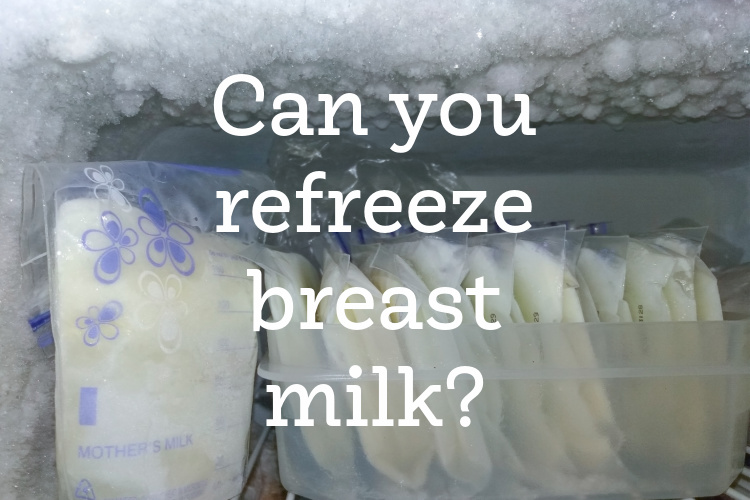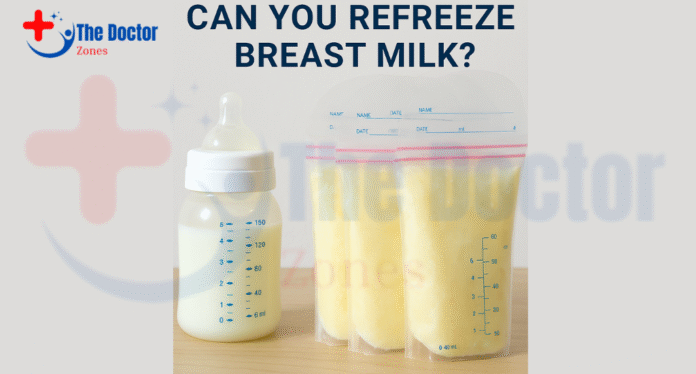Can You Refreeze Breast Milk? The Complete 2025 Mom’s Guide
Introduction: Real Talk, Real Life
You planned. You pumped. You froze it perfectly.
Then life happened — the baby didn’t finish the bottle, the freezer door was left open, or you pulled out more milk than needed.
Now you’re standing there, tired and worried, asking yourself:
“Can you refreeze breast milk?”
Let’s walk through the truth—with science, common sense, and a lot of mom-to-mom understanding.
Quick Answer: Can You Refreeze Breast Milk?
Yes, you can refreeze breast milk, but only under very specific conditions:
If the milk is still partially frozen (with visible ice crystals) – you can refreeze.
If the milk is completely thawed and liquid – you should not refreeze.
Golden Rule:
If it still looks like it came from the freezer (even a little), it’s safe.
If it looks like it came from the fridge, it’s not.
Read more about: Oropouche Virus Sloth Fever: What You Must Know About This Emerging Threat in 2025
Why Refreezing Fully Thawed Milk is Risky
-
Nutritional Loss: Repeated freezing and thawing can weaken immune-boosting properties, vitamins, and fats.
-
Bacterial Growth: Once thawed, breast milk is more vulnerable to bacteria, even if refrozen.
-
Taste Changes: Milk that’s refrozen can develop a soapy or metallic taste, leading to bottle rejection by picky babies.
-
Texture Issues: Fat separation can make the milk lumpy or oily.
In short: it’s about keeping your baby’s milk as safe, nutritious, and tasty as possible.
When It’s Safe to Refreeze Breast Milk
| Situation | Safe to Refreeze? | What You Should Do |
|---|---|---|
| Milk has visible ice crystals | Yes | Refreeze immediately |
| Milk is cold but fully liquid | No | Store in fridge, use within 24 hours |
| Milk was left out at room temp | No | Discard if left for over 2 hours |
| Baby drank from the bottle | No | Discard leftover milk |
| Freezer partially defrosted but milk still frozen | Yes | Refreeze safely |
Why Moms Freeze Breast Milk (and Worry About Wasting It): Can You Refreeze Breast Milk
Breast milk isn’t just food—it’s time, love, and energy in a bottle.
Common reasons for freezing milk:
-
Building a stash for maternity leave or emergencies
-
Preparing for travel or work
-
Helping manage illness or medications
-
Donating milk to other families
Every ounce matters. That’s why wasting milk feels so frustrating—and why knowing the rules about refreezing can save your precious stash.
Discover more: Is There a New Virus Going Around? Here’s What You Need to Know in 2025
Tips to Minimize Wasted Breast Milk: Can You Refreeze Breast Milk

-
Freeze in small portions (2–4 oz) to thaw only what you need.
-
Label everything with date and time.
-
Use oldest milk first (First In, First Out method).
-
Thaw slowly in the fridge whenever possible.
-
Have a backup cooler with ice packs for travel days or emergencies.
Small planning steps = major stress relief later!
Science Behind Freezing & Refreezing: Can You Refreeze Breast Milk
When milk freezes, the cold slows down bacterial growth and locks nutrients in place.
However, freezing and thawing breaks down fragile components like:
-
Antibodies
-
Enzymes
-
White blood cells
Each thawing cycle can decrease the “living” quality of breast milk slightly. That’s why limiting the number of freeze-thaw-refreeze cycles keeps milk closer to its original, powerful state.
How to Tell If Thawed Milk Is Spoiled: Can You Refreeze Breast Milk
Use your senses:
-
Smell: Spoiled milk smells sour or metallic.
-
Taste: If safe, it should taste sweetish, not bitter or rotten.
-
Look: Chunky, discolored, or moldy-looking milk should always be tossed.
Trust your gut, mama. If it feels wrong, don’t feed it.
Breast Milk Storage Safety Chart
| Storage Location | Temperature | Duration |
|---|---|---|
| Room Temperature (up to 77°F / 25°C) | Up to 4 hours | |
| Refrigerator (≤ 40°F / 4°C) | Up to 4 days | |
| Freezer (0°F / -18°C) | 6 months (ideal), 12 months (acceptable) | |
| Deep Freezer (-4°F / -20°C) | 12 months |
Special Situations: What If There’s a Power Outage?
-
Keep the freezer closed as much as possible.
-
Check the milk: If it still has ice crystals, refreeze it.
-
Use coolers with dry ice if needed during long outages.
In an emergency, always prioritize safety over saving milk.
Conclusion: Real Life, Real Choices
Motherhood isn’t about perfection.
It’s about making the best choice with the information you have — and sometimes that means making peace with a little lost milk to protect your baby’s health.
You’re doing incredible work, mama.
Every bag you freeze, every bottle you warm, every feeding you give—it’s all part of your amazing story.
FAQs About Refreezing Breast Milk
Q1: Can you refreeze thawed breast milk after a power outage?
A: Only if there are still ice crystals. Fully thawed milk should not be refrozen.
Q2: Can I refreeze leftover milk from a bottle my baby drank from?
A: No. Once a baby drinks from a bottle, bacteria enter the milk.
Q3: Does refreezing ruin the milk?
A: Refreezing once, if ice is present, is safe but may slightly lower nutritional quality.
Q4: Is it okay to use partially thawed milk within 24 hours?
A: Yes! Store it in the fridge and use within 24 hours.
Q5: What’s the safest way to thaw breast milk?
A: In the fridge overnight or under cool running water—never microwave!





